Chapter 2: Improving Employment Support
Updated 30 July 2021
Applies to England, Scotland and Wales
This is a summary of analysis to support Chapter 2 of Shaping Future Support: The Health and Disability Green Paper. The publication covers information on working age health and disability benefits in Great Britain.
This includes:
- the disability employment rate and number of disabled people in employment
- people who are approved for Access to Work elements
- people in the assessment phase or fit note phase of Employment and Support Allowance (ESA) or Universal Credit (UC)
- work aspirations of people receiving ESA or UC*
- benefit to the exchequer and wider society of a disabled person in work
- sanctions of people who receive ESA
- evidence of a new conditionality approach for people receiving disability benefits
- factors linked to health related job loss and recovery from a health problem
- how support can help disabled people feel more ready to move into employment
- what support disabled people commonly take up
- how Department for Work and Pensions (DWP) programmes have supported disabled people into work
- disability starts to the Work and Health Programme
- internet access of disabled people
What you need to know
The data in this evidence pack comes from a range of sources that are referenced in the accompanying data tables. The new data presented here includes analysis from:
- 100% DWP administrative data of people receiving:
- ESA
- UC
- Disability Living Allowance (DLA)
- Personal Independence Payment (PIP)
- 100% DWP administrative data of Work Capability Assessments and PIP assessments, mandatory reconsiderations (MRs) and appeals
- 100% DWP administrative data of people attending employment programmes
- 100% HM Revenue and Customs (HMRC) administrative data of P14 and P45 records of people receiving DWP benefits.
- DWP Benefit Caseload and Expenditure Outturn and Forecasts
- DWP commissioned research reports
- other research reports
- survey data
Data tables, which provide more details on the data and analysis presented here, are available online.
1. Main stories
The statistics show:
- the disability employment rate and number of disabled people in employment have been increasing
- the number of people with an Access to Work provision approved has been increasing
- there are normally around 290,000 people on the ESA assessment phase or on UC* with a fit note
- some disabled people would like to work when their condition allows
- a disabled person in-work, instead of out-of-work, allows the government to re-invest £15,000 a year
- only people in ESA Work Related Activity Group (WRAG) can receive a sanction on ESA, and this happens in less than 1% of cases
- a more personalised conditionality approach with disability benefit claimants aims to improve trust
- new health problems increase the risk of job loss; recovery supports movements into work
- support can help people to improve their confidence and feel more ready to move into employment
- not everyone offered support uses it, most commonly when their health is not good enough
- DWP programmes have demonstrated what works with supporting disabled people into employment
- on average, 32% of Work and Health Programme (WHP) Disability starts have First Earnings from employment within 12 months
- over 80% of people receiving income-replacement and extra-cost benefits have internet access
2. The disability employment rate and number of disabled people in employment have been increasing
Percentage of working age disabled and non-disabled people in employment since 2014
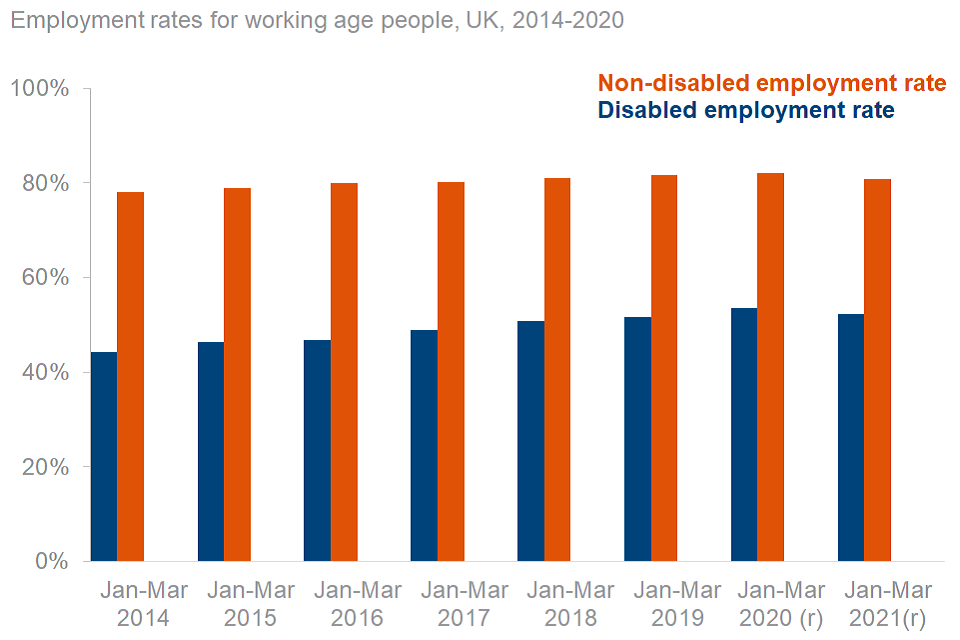
Source: A08: Labour market status of disabled people
Since 2014 the disability employment rate had been increasing, but it decreased as the impact of the coronavirus pandemic was seen.
The proportion of working age disabled people in work had been increasing from 2014 to 2020. The employment rate for non-disabled people had also been increasing, but at a slower rate.
In 2014, the employment rate for disabled people was 44%, and the employment rate for non-disabled people was 78%. The disability employment gap – the difference between the employment rates of disabled and non-disabled people – was therefore 34 percentage points.
The employment rate for disabled people and non-disabled people decreased as the impact of the coronavirus (COVID-19) pandemic was seen. In 2021, the employment rate for disabled people was 53% and the employment rate for non-disabled people was 81%. The disability employment gap was 28 percentage points.
The number of disabled people in employment since 2014
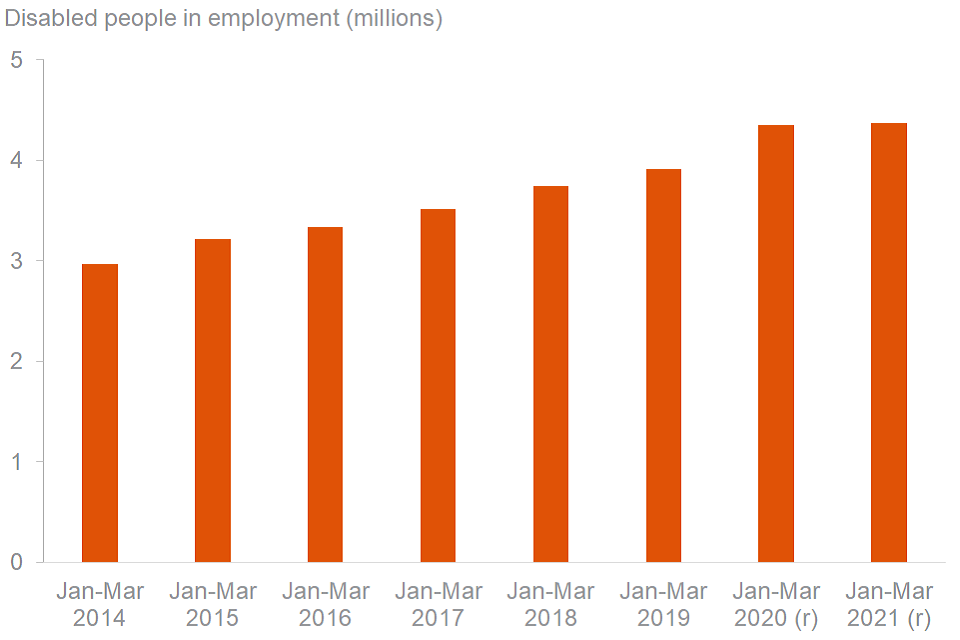
Source: A08: Labour market status of disabled people
The number of disabled people in work has increased since 2013.
The total number of disabled people in employment has been increasing since 2014. In the three months from January – March 2019, 3.9 million disabled people were in employment, compared to 3.0 million in the same three months in 2014. The total number of all people in employment has increased from 26.2 million in 2014 to 27.3 million in 2019.
The Conservative Party 2017 manifesto pledged to see1 million more disabled people into employment over the next ten years. In the first four years of the goal the number of disabled people in employment increased by 850,000.
Figures for the first quarter of 2021 showed that, in the first four years of the goal (between the first quarter of 2017 and the first quarter of 2021), the number of disabled people in employment had increased by 850,000. This an increase of 14,000 since the first quarter of 2020.
Progress towards seeing 1 million more disabled people in employment in the decade to 2027
| Year (first quarter) | Number of disabled people in employment (Millions) | Progress towards 1 million goal (Number) | Percentage |
|---|---|---|---|
| 2018 | 3.74 | 230,000 | 23% |
| 2019 | 3.92 | 400,000 | 40% |
| 2020 | 4.35 | 840,000 | 84% |
| 2021 | 4.37 | 850,000 | 85% |
3. The number of people with an Access to Work provision approved has been increasing
Thousands of disabled people are approved for an Access to Work provision each year

Source: Access to Work statistics
The number of people who have had an Access to Work provision approved has increased since 2015 to 2016.
Access to Work is a programme that aims to help people who have a disability or long-term health condition start or stay in work. People are offered support based on their needs, which may include a grant to help cover the costs of practical support in the workplace. An Access to Work grant can pay for things like special equipment, adaptations or support worker services and help getting to and from work.
There are two main types of Access to Work provision: Assessments and Elements. More than one item of Access to Work provision of the same type or of different types can be approved for the same person in a given financial year or in different financial years.
The number of people who had any Access to Work provision approved has increased since 2015 to 2016, at the same time as an increase in people receiving an element, for example adaptations, communication support, travel to work or Mental Health Support services.
Thousands of disabled people are approved for different elements of Access to Work each year
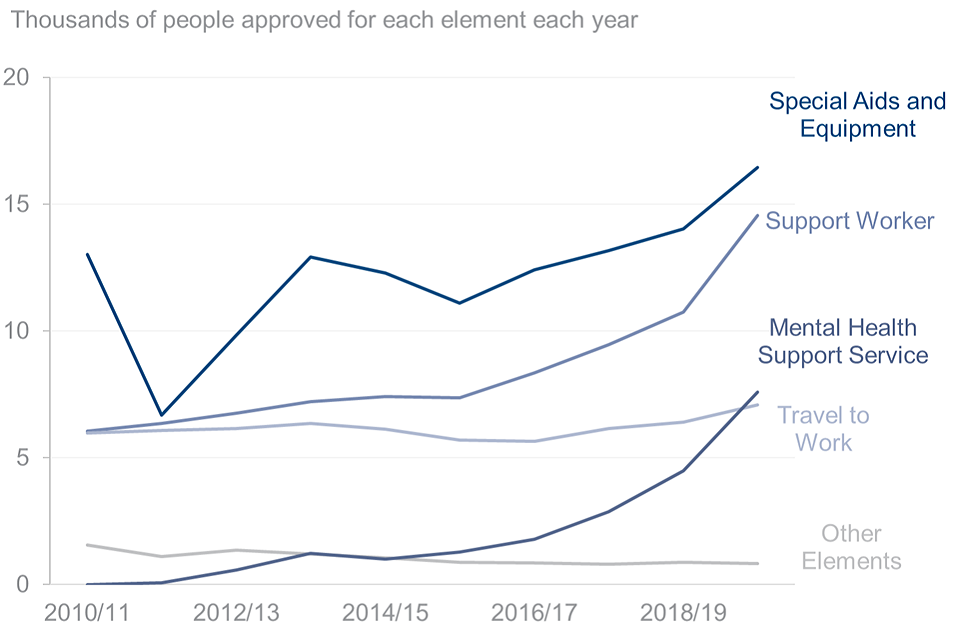
Source: Access to Work statistics
The number of people who have had Access to Work elements for Support Workers or Mental Health Support Service has increased over time.
There are many elements of access to work including:
- Adaptation to Premises
- Adaptation to Vehicles
- Communication Support for Interviews
- Travel in Work
- Special Aids and Equipment
- Support Worker
- Travel to Work
- Mental Health Support Service
- Miscellaneous
The number of people accessing Support Worker, Mental Health Support Service and Special Aids and Equipment elements have been increasing since 2015 to 2016, while the remaining elements have not seen similar increases.
4. There are normally around 290,000 people on the ESA assessment phase or on UC with a fit note
The number of people in the ESA Assessment Phase or on UC with a fit note
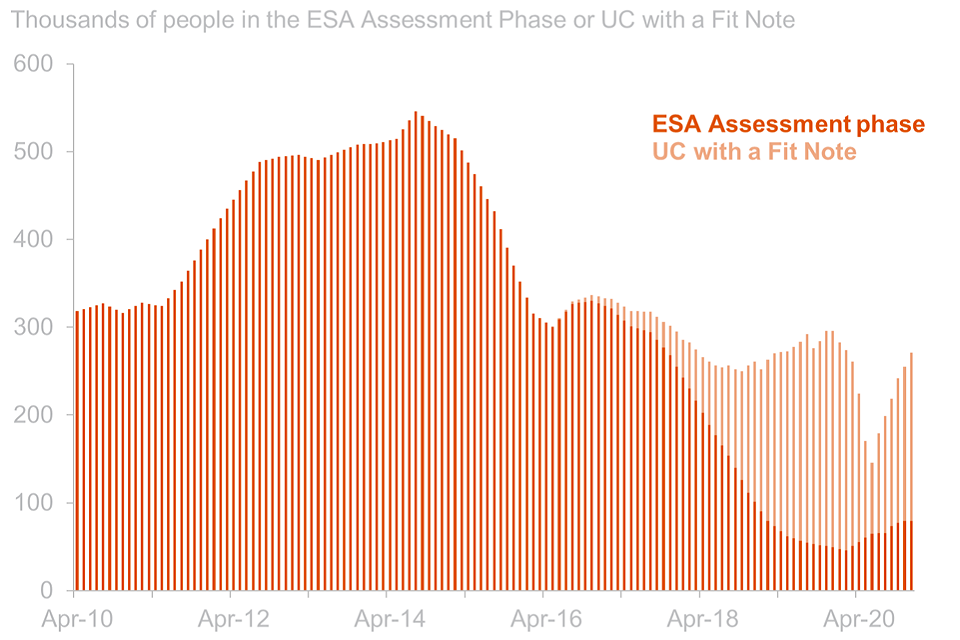
Source: DWP administrative and management information data
The number of people in the assessment phase of ESA of UC* with a fit note has decreased since a peak in 2014.
The number of people in the assessment phase of ESA or on UC* with a fit note has decreased since a peak in 2014. People in these groups can be assessed to see how their health limits how much work they can do in an initial Work Capability Assessment (WCA).
In April 2010 there were 320,000 people in the assessment phase of ESA. This increased to a peak of 510,000 in April 2014, before returning to 330,000 in September 2016.
Between January 2016 and March 2020 the average number of people in the ESA assessment phase or on UC* with a fit note each month is 294,000 people.
There was a decrease in the number of people in these groups at the start of the coronavirus (COVID-19) pandemic and the first UK-wide lockdown. From July 2020, the number of people in these groups increased again and reached 270,000 in December 2020.
The number of ESA new claims closed before an initial WCA each month
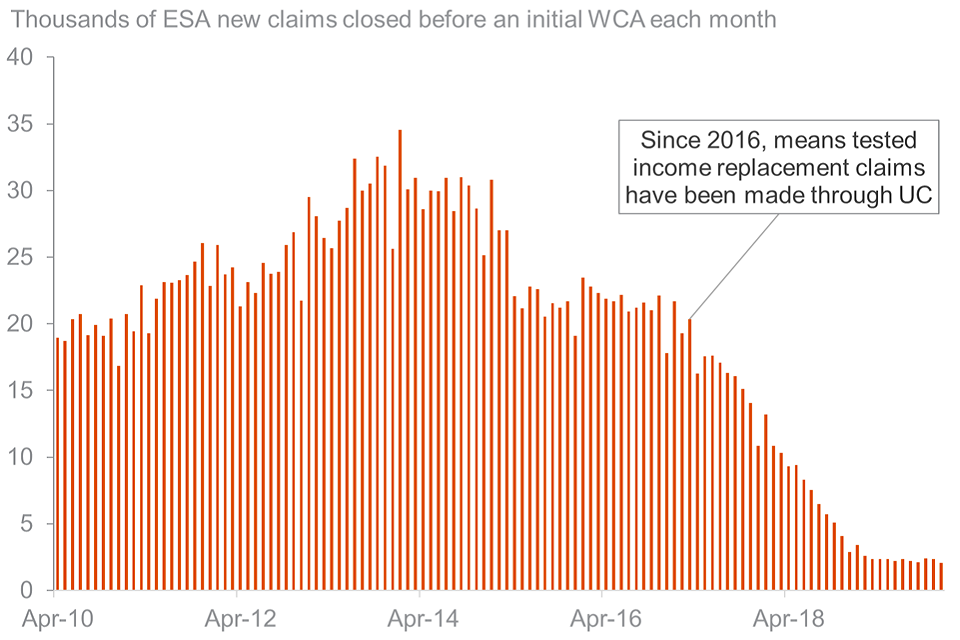
Source: Work Capability Assessment Outcomes by Claim Start
Thousands of new ESA claims closed before a WCA peaked in January 2014.
When ESA new claims close before a WCA, this means that the person left the benefit before an initial assessment of their limitation for work.
In April 2010, 19,000 new claims were closed before a WCA was completed. This number rose over time to a peak of 35,000 claims being closed in January 2014. After this, the number of claims closed before assessment decreased, and was 22,000 in January 2017.
Since 2016, means tested income replacement benefit claims have been made through UC. People are not required to close their claim to UC when they no longer have a health condition that limits how much they can work, therefore people closing new claims to UC cannot be compared to people closing their claim on ESA. This has reduced the number of people in the ESA assessment phase, and therefore reduced the number of people who close their new claims each month.
In December 2019, 2,000 ESA new claims were closed before assessment
5. Some disabled people would like to work when their condition allows
Extent to which people on PSP would like to work in the future
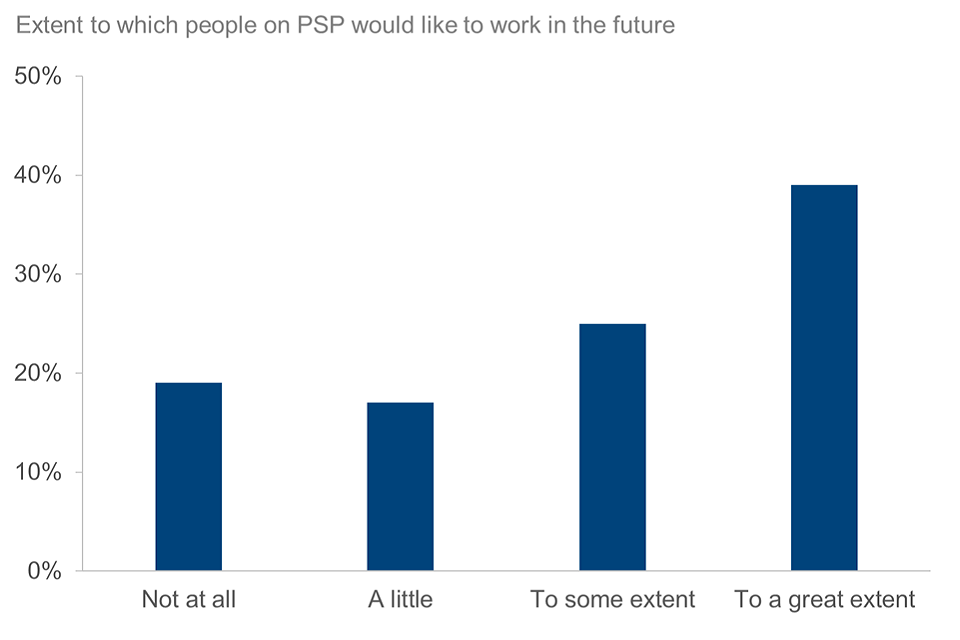
Source: Personal Support Package Evaluation
Nearly two thirds of people who were eligible for the Personal Support Package (PSP) would like to work to some or a great extent.
The Personal Support Package (PSP) was introduced from April 2017 to support people receiving ESA or UC*. In a survey of 1,800 people who were eligible for the PSP, respondents who were not in paid employment were asked to what extent they would like to find paid employment in the future, either full or part time.
A majority of people said they would like to work to a great (39%) or some (25%) extent. 19% of respondents did not want to find work at all.
Extent to which people in the Support Group and LCWRA could work in the future
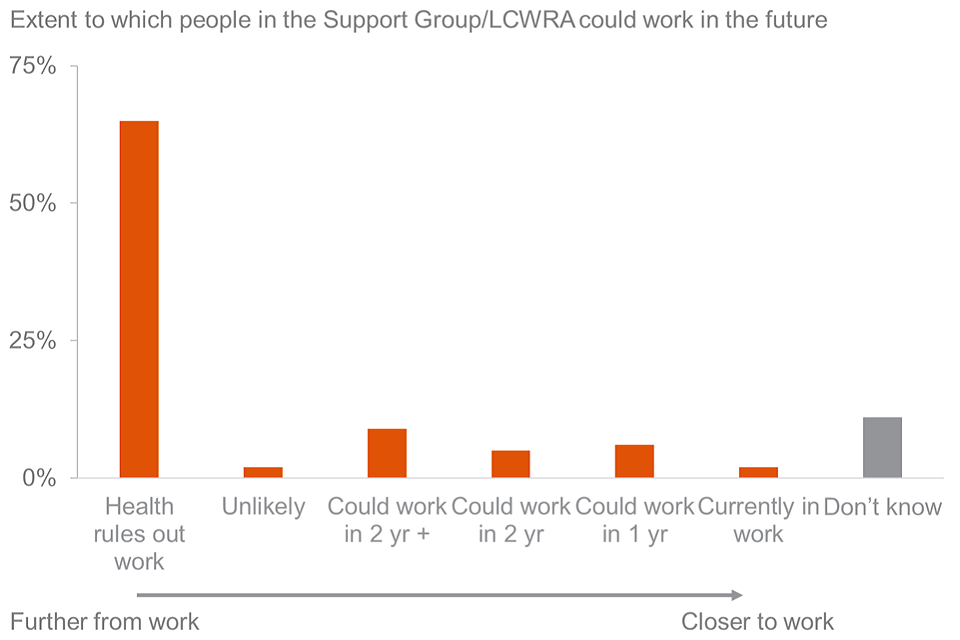
Whilst most of Support Group and LCWRA people have health conditions ruling out work, 20% could work in the future.
In a survey of 2,000 people in the ESA Support Group and UC equivalent group, respondents were asked when they believed paid work could be possible.
65% of respondents ruled out work in the future on health grounds. A further 2% did not completely rule out work on the grounds of their health, but nevertheless indicated that it was unlikely. 2% of respondents were already undertaking some paid work at the time of the survey. 20% of respondents reported that paid work could be possible in the future. There was a fairly even split between those who felt they might be able to work within the next two years, and those who felt they might be able to work in the further future. 11% did not know whether they could work in the future.
6. A disabled person in-work, instead of out-of-work, allows the government to re-invest £15,000 a year
Benefit to the exchequer of a disabled person in work
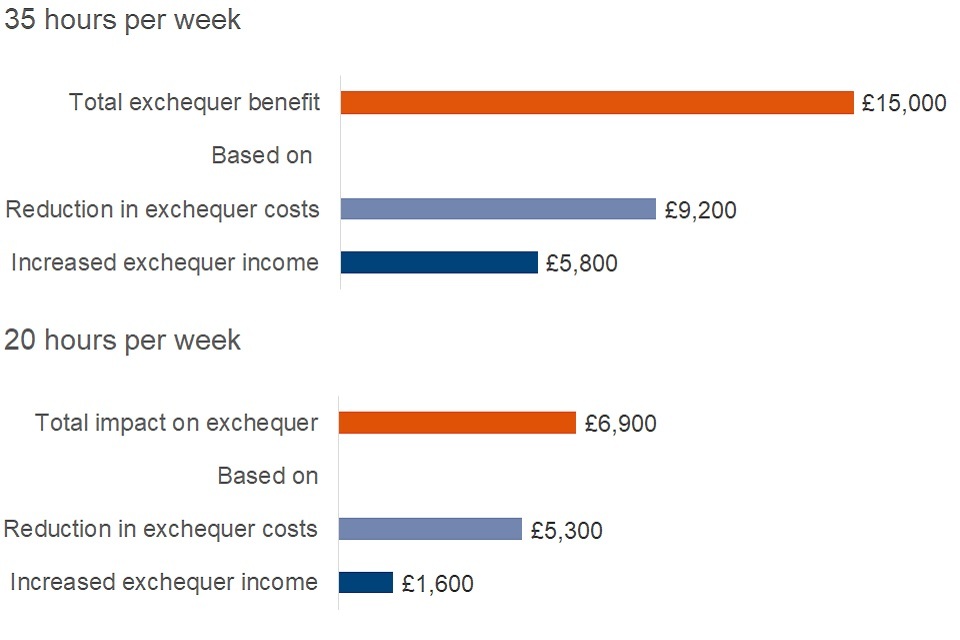
Source: DWP Social Cost Benefit Model
One disabled person in work instead of out of work has an annual benefit to the exchequer of £15,000 for full-time work or £7,000 for part-time work.
Having one extra disabled person in full-time work, rather than being out of work longer term, would mean Government could save and re-invest £15,000 a year for full time work of 35 hours per week, or £7,000 a year for part time work of 20 hours per week. Society could benefit £21,000 per year for full time work, or £22,000 including distributional effects, and £11,000 per year for part time work, or £13,000 including distributional effects.
This analysis is based on the DWP UC Social Cost Benefit Analysis Model. The calculation for each number of hours worked is based on an individual disabled person on UC with the LCWRA award. The examples use a single person, over the age of 25, with no children and no caring responsibilities. The person is assumed to earn the median hourly wage for someone with a disability (£10.63) and pay the average rent (social and private) for a single person with no children, taken from 2017 Single Housing Benefit Extract data. It assumes the individual is claiming UC when in and out of work and it compares being in work for 1 year to being out of work for 1 year. The exchequer impacts exclude distributional and substitution effects. It does not take account of employment intervention/programme costs. Figures are in 2021 to 2022 prices.
Hours of paid work people in the ESA Support Group or UC* LCWRA who already work or want to work in the future are interested in

Of people in the ESA Support Group or UC LCWRA group who feel they could enter paid work, most would be interested in part-time work.
In a survey of 2,000 people in the Support Group on ESA or LCWRA group on UC, 431 respondents who were already in paid work (n=42) and those who felt that paid work was possible in the future (n=389), were asked how many hours of work they were interested in.
Of these, 30% indicated that they would be interested in full-time work, while 63% indicated they would be interested in part-time work of up to 30 hours per week.
7. Only people in ESA WRAG can receive a sanction on ESA, and this happens in fewer than 1% of cases
Original adverse sanction decisions on ESA WRAG
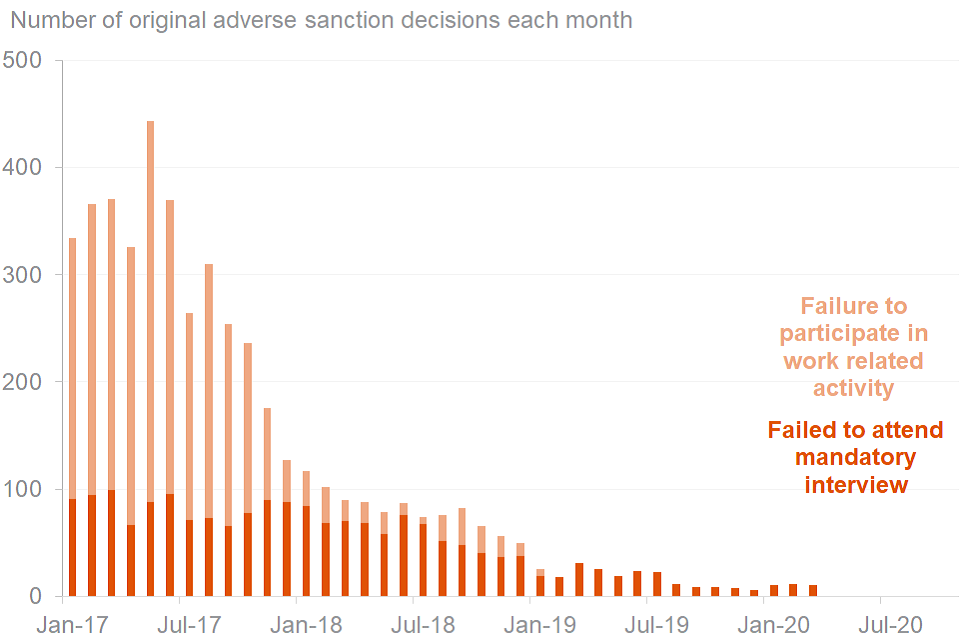
Source: Benefit sanctions statistics
Between January 2017 and October 2020 there have been a total of 4,800 original adverse sanction decisions on the ESA WRAG group.
People on ESA in the Support Group do not have to attend interviews and are not subject to sanctions. Those in the ESA Work Related Activity Group (WRAG) may be expected to attend regular interviews with their Work Coach and undertake Work-Related Activity (WRA), which should be reasonable and appropriate for the person, based on their health condition or disability.
A sanction can be imposed for two reasons. These are:
- failure to attend Mandatory Interview without good reason
- failure to participate in WRA without good reason
People on ESA who receive a sanction have the personal allowance aspect of their benefit stopped until they comply with the interview requirement or work-related activity. Not all original adverse decisions lead to a sanction deduction following review, mandatory reconsideration or appeal.
The number of original adverse sanction decisions on the ESA WRAG group has been falling. Since January 2017, the number of sanctions has fallen to less than 500 per month. There were no adverse sanctions applied between April 2020 and October 2020.
Proportion of the ESA WRAG group with a sanction applied
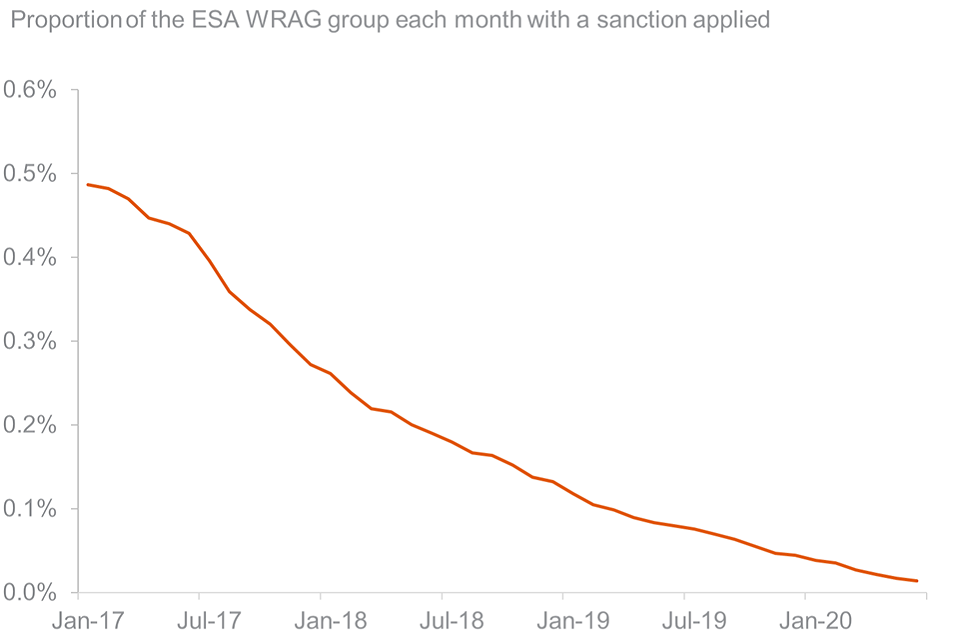
Source: Benefit sanctions statistics
Since January 2017 fewer than 1% of people in the ESA WRAG group have had a sanction applied.
In June 2020, 0.01% of people in the ESA WRAG group had a deduction taken from their personal allowance as a result of a sanction.
8. A more personalised conditionality approach with people receiving disability benefits aims to improve trust
Aims of the new approach to conditionality
-
Better tailoring and personalisation of work related requirements, to ensure they are reasonable and appropriate for people.
-
Improved trust, engagement and better relationships between Work Coaches and people they work with.
-
Improvements in the way conditionality is applied.
This new approach to conditionality for people receiving disability benefits aims to personalise work-related requirements and improve trust.
Conditionality is work-related activity that a person is required to do as a condition for receiving financial support. If they fail to undertake the work-related activity that they have agreed, without good reason, then their benefit may be reduced, known as a sanction. For disabled people, work-related activity can mean carrying out work-search and/or doing activities to move towards work such as preparing a CV.
A new approach to conditionality has been designed to improve the relationship between people receiving disability benefits and their Work Coach. This applies to people in the ESA WRAG group and the equivalent group on UC (LCW), and to people waiting for a WCA. Work Coaches have the option of applying no mandatory requirements if they feel this is appropriate for individual circumstances, but instead are encouraged to set voluntary steps the individual could take to progress their employment journey. Using their discretion, Work Coaches apply mandatory requirements only if they are needed.
The new approach was used in 29 Jobcentres between September 2019 and February 2020. To evaluate this approach, 34 research interviews were conducted with Jobcentre staff covering Work Coaches, Work Coach Team Leaders, Disability Employment Advisers and Customer Service Leads. Interviews were conducted by telephone and face to face. The interviews were spread across 6 Jobcentres which were selected to represent a range of office sizes and previous sanction referral rates.
Staff response to new conditionality approach
| Staff response to new conditionality approach |
|---|
| Staff welcomed the opportunity to use more discretion in working with people receiving disability benefits |
| Staff said the new approach has led to more effective working between disabled people and Work Coaches |
| The new approach has recognised existing practice |
Staff said that the new approach helped them to build better relationships with people and provide more tailored support.
There was a belief amongst staff that conditionality should be applied with caution for people receiving disability benefits and that mandating people to undertake work-related requirements can be counterproductive in some cases. As one Work Coach Team Leader noted:
Work Coaches are not processors and shouldn’t treat everyone the same. They get satisfaction from moving people forward and being able to use their discretion on how to do this.
Staff perceived that a more personalised, flexible approach to conditionality builds relationships, a better understanding of people’s circumstances, and hence helps disabled people and Work Coaches work together more effectively.
There was also a view that the new approach reflects the existing practice of some staff who had recognised the need to tailor their work with people with disabilities and health conditions.
9. New health problems increase the risk of job loss; recovery supports movements into work
Characteristics of people remaining in work with health problems
| Factors that reduce the risk of job loss when a health problem arises |
|---|
| Working for a larger employer |
| Working in a skilled occupation |
| Having a degree |
Several factors affect the likelihood of job loss following a new health problem.
Longitudinal research[footnote 1] has found that changes in health status, including the onset of limiting long-term illness or disability, are linked with employment outcomes.
Around half of working age people whose general health becomes poor in a year remain in employment, and half leave employment. Being employed in a larger organisation with over 200 employees, working in a skilled occupation and having a degree appear to mitigate the risk of job loss when health problems arise.
Factors linked with a faster recovery from a health problem
| Factors linked with a faster recovery from a health problem |
|---|
| Being in employment |
| Younger age (16 to 24) |
| Children under 16 in household |
| Being a home owner |
| White ethnicity |
The likelihood and speed of recovery from a health problem affect employment outcomes.
A key factor associated with recovery from a health problem is being in employment[footnote 1]. A range of evidence shows that good work is generally good for physical and mental health and wellbeing[footnote 2].
Among people out of work, recovering from poor health is linked with a greater likelihood of moving into work in the same period, particularly among people with poor mental health[footnote 1]. However, new health problems are more frequently linked with job loss than recovery is linked with movements into work.
Younger people, those aged 16 to 24 years, are more likely to recover from the onset of poor health, and do so more quickly, than older age groups. However, the opposite appears to be true where a mental health condition is concerned.
Recovery from a health problem also has benefits for people in work. For example, people who recover from mental health conditions are more likely to move from low-paid to high-paid jobs in the same period.
10. Support can help people to improve their confidence and feel more ready to move into employment
Experience of support among PSP survey respondents who took up support
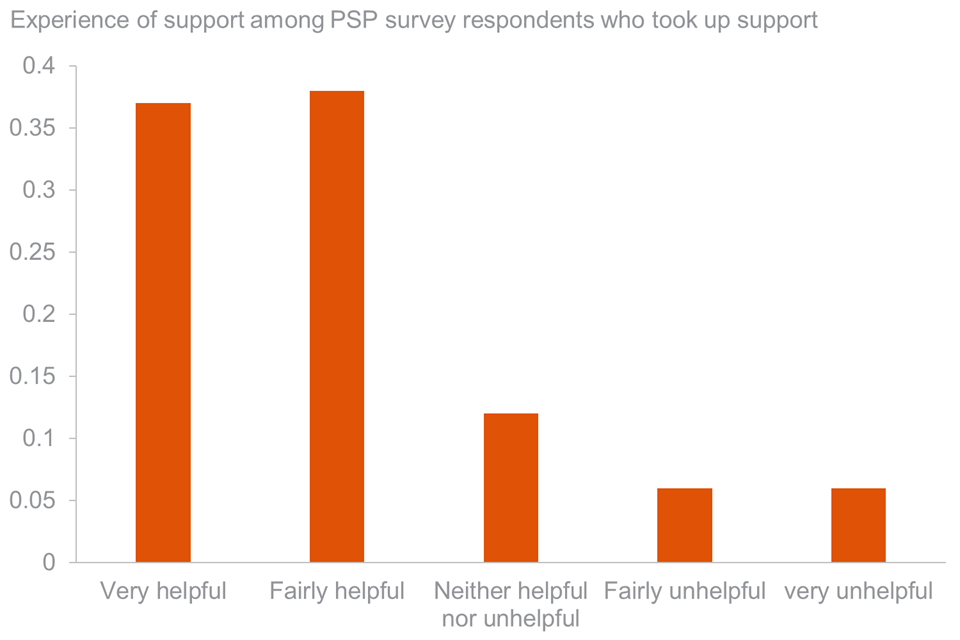
Source: Personal Support Package Evaluation
The majority of people on PSP who took up employment support reported they found it helpful.
In a survey of people who were eligible for the Personal Support Package, 75% of people who said they received support from a Work Coach reported that they had found it helpful.
42% of people who had accessed support said that their confidence increased as a result of the support and advice they had received from their Work Coach.
Among those who took up support, 12% found some form of work, another 8% had found permitted work, another 3% had found part-time work, and a final 3% had found full-time work.
Disabled people’s views as a result of the JCP support given
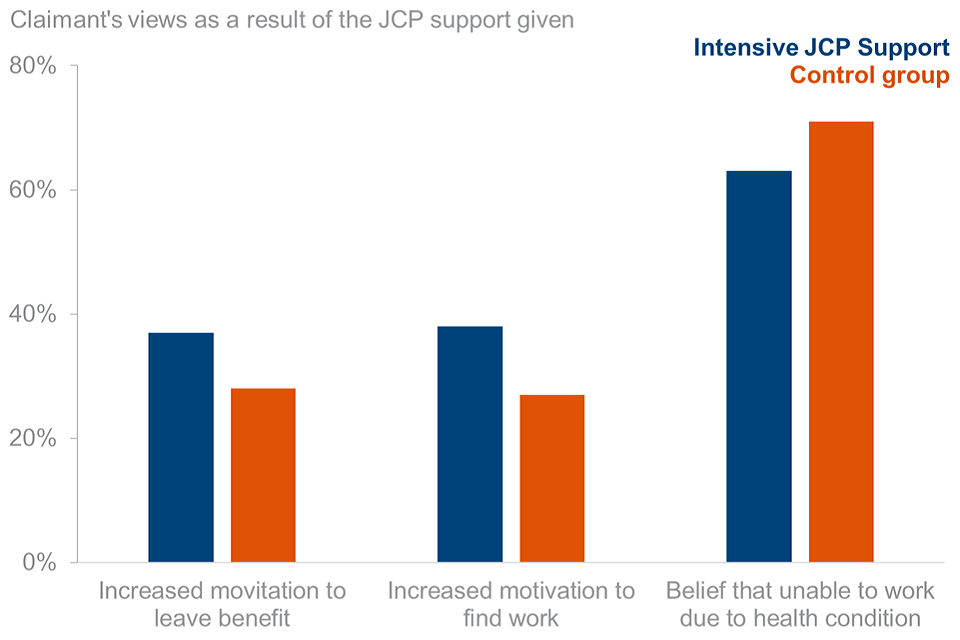
Intensive support from DWP staff has led to reduced time on benefit and more positivity about work.
From 2013 to 2016 pilots were conducted to test the effectiveness of enhanced support for people receiving ESA. Three distinct models were piloted: the Jobcentre Plus (JCP) model; the Work Programme (WP) model; and the Healthcare Provider (HCP) model.
Analysis of outcomes found minimal employment impacts across the three pilots, but some reduction in days on benefit, in particular the JCP and WP pilots.
Findings suggest that the JCP model had an impact on soft outcomes such as participant motivation to leave ESA and to find work. 37% of pilot participants reported increased motivation to come off ESA as a result of the support received, compared with 28% in the control group. 38% of participants said they were more motivated to find work as a result of support received, compared with 27% in the control group. The belief that they are unable to work due to health condition was lower in the pilot group than in control group, 63% of participants compared to 71% of the control group.
11. Not everyone offered support uses it, most commonly when their health is not good enough
Proportion of PSP survey respondents that took up support offered
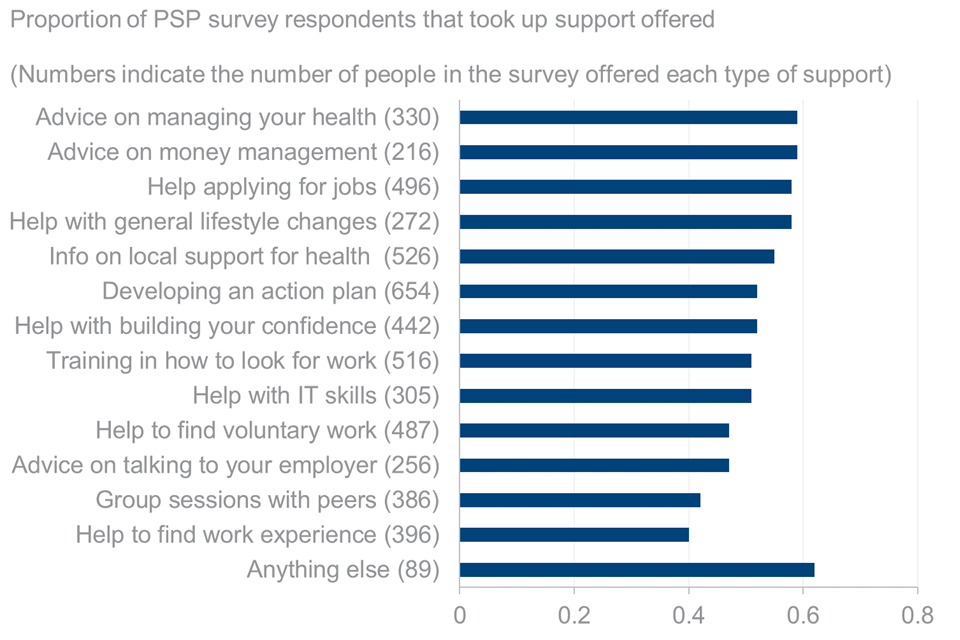
Source: Personal Support Package Evaluation
Over half of the people responding to a PSP survey after taking up support had received help with applying for jobs.
65% of people in a PSP survey recalled being offered some form of support, such as help with job search, condition management, money management or developing an action plan and 42% of all people took up at least one of the options offered.
Of PSP survey respondents who took up some support that was offered, advice on how to manage your health condition or disability, money management and help applying for jobs were the types of support that were most commonly used by respondents.
A survey of people in the ESA Support Group and equivalent group on UC found that 32% were interested in receiving support in the future, either with work or with wider issues such as housing, finances or finding volunteering opportunities. 39% of people in the ESA Support Group would welcome Jobcentre Plus contacting them about receiving additional help, provided this was sensitively worded and made clear taking up support is voluntary.
PSP survey respondents reporting barriers to taking up support offered
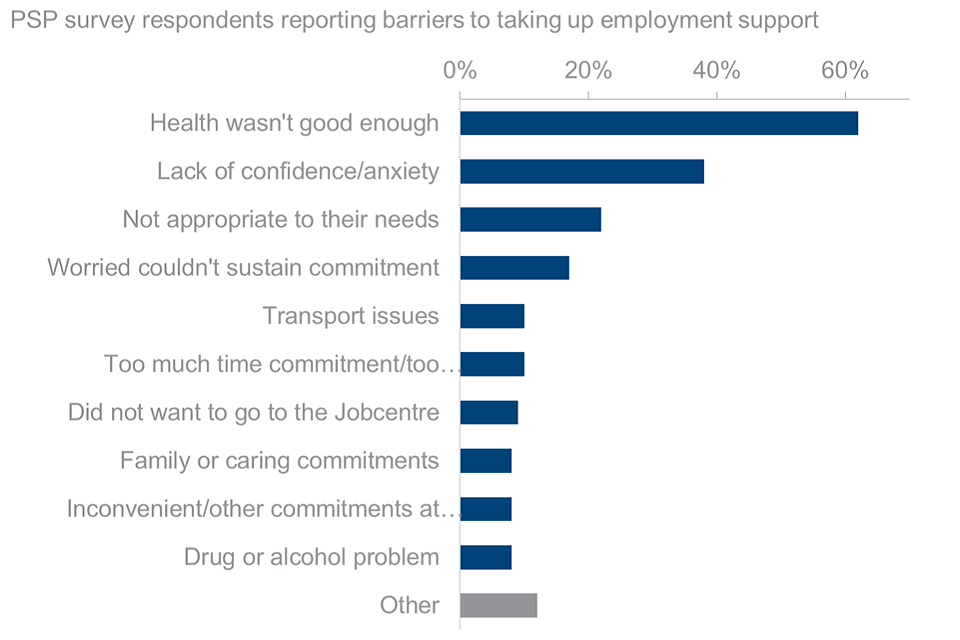
Source: Personal Support Package Evaluation
Along with their health conditions, disabled people report a lack of confidence/anxiety and employment support not being appropriate to their needs.
PSP survey respondents were asked for the reason as to why they did not take up any employment support.
The biggest barrier to people taking up support was because their health was not good enough (62%).
The next most reported barrier was lack of confidence or anxiety (38%), followed by the support not being appropriate to their needs (22%) and feeling worried that they could not sustain the commitment required (17%).
Other reported barriers included transport issues (10%), concerns that the employment support involved too much time commitment or was too intensive (10%) and not wanting to go to the Jobcentre (9%).
Reasons such as family or caring commitments, other commitments or problems with drugs or alcohol were reported by fewer people.
12. DWP programmes have demonstrated what works with supporting disabled people into employment
| Name of programme | Brief description | Results |
|---|---|---|
| ESA WRAG 18-24 Month prognosis pilots | Three options were tested all of which lasted two years. Intensive support from Jobcentre Plus. Referral to the externally provided Work Programme. Regular meetings with Health Care professionals. Tested by Randomised Control Trial. | JCP reduced time on benefit by 19.3 days over 3 year period compared to control group. Most of the impact seen in the first two years. WP model reduced time on benefit by 14.6 days over 3 year period, compared to control group. Most of the impact seen in first two years. No impact on time on benefit for HCP model compared to control over 3 year tracking period. |
| More Intensive Support | Mandatory additional Work Coach support to people on ESA WRAG who had completed WP (and not left benefit). Additional support of 264 minutes over a six month period, compared to a BAU of 44 minutes over six months. Tested via Randomised Control Trial | Small positive impact of 3.2 additional days off benefit over the first 12 months compared to control group. |
| Support for the Very Long-term Unemployed | Two models tested for people who have received JSA for a long time. One model was mandatory work experience placements. The other model was intensive support from JCP. Sub-group analysis looked at impact for people on JSA with a disability marker. Tested by Randomised Control Trial. | Intensive JCP support participants with a disability marker spent 27 less days on benefit over 91 week period and 13 extra days in employment over the same time period. The impacts were lower for the mandatory work experience: 10 less days on benefit and 3 more days in employment. |
Evaluations of DWP programmes compare long-term outcomes for participants with outcomes for a matched group of non-participants.
13. On average, 32% of WHP Disability starts have First Earnings from employment within 12 months
Starts to the Work and Health Programme disability group
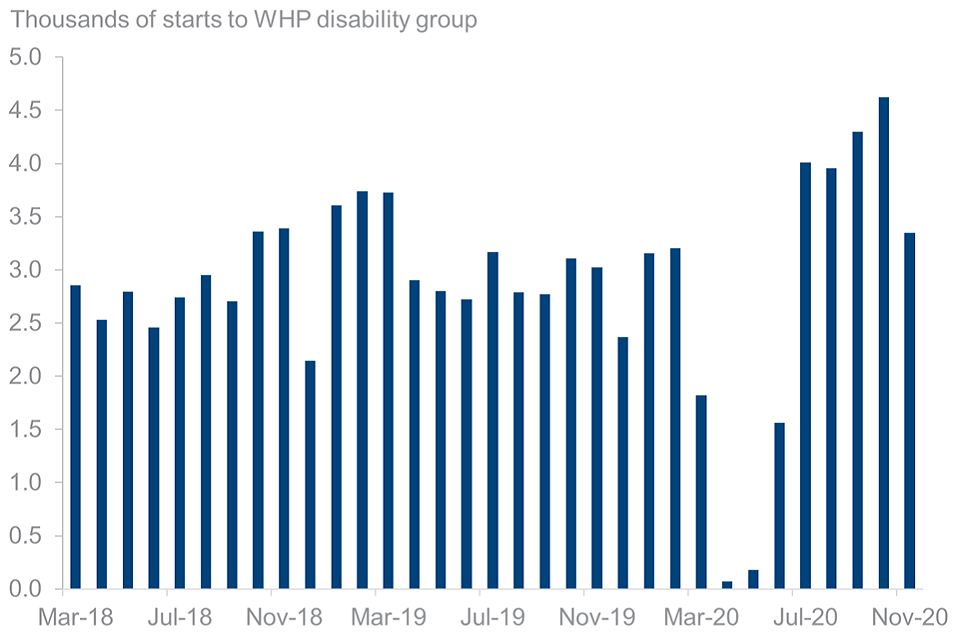
Source: Work and Health Programme statistics
There was a monthly average of 3,000 disability starts on the Work and Health Programme (WHP) between March 2018 and February 2020.
The Work and Health Programme was introduced in November 2017, and was launched in North West England and Wales. It is intended to help individuals find and keep a job if they are out of work. In March 2018, the programme became available in all parts of the country.
Between March 2018 and February 2020 between 2,100 and 3,700 disability group starts were recorded each month. There was a decrease in disability starts as the impact of the start of the coronavirus (COVID-19) pandemic and the first UK-wide lockdown was seen. From July 2020 the number of monthly individual referrals and starts returned to similar levels to those seen before the pandemic, reaching a peak of 4,600 disability starts in October 2020.
Disability group starts achieving first earnings from employment within 12 months of starting
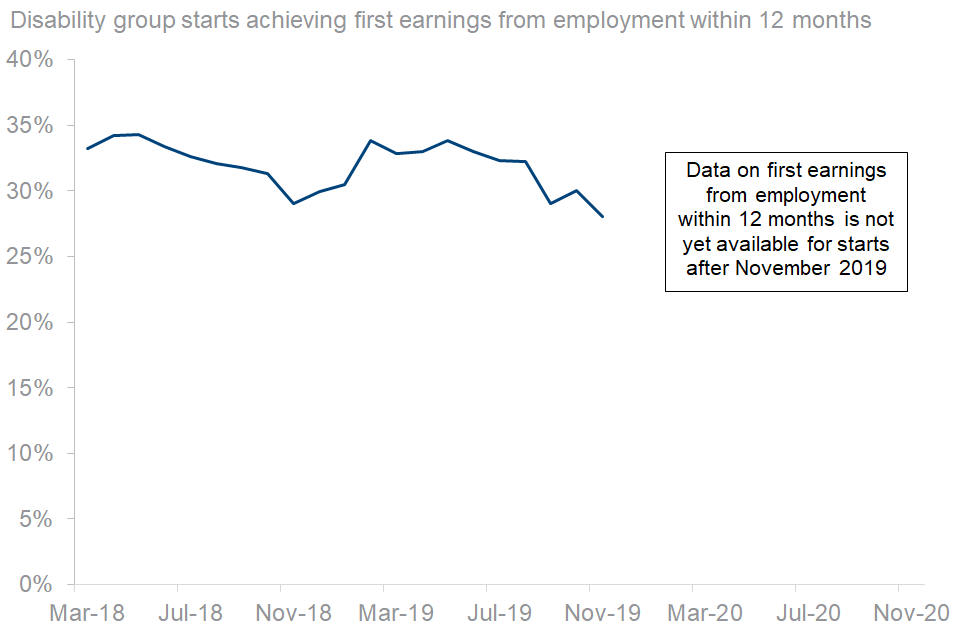
Source: Work and Health Programme statistics
An average of 32% of WHP disability starts between March 2018 and November 2019 reported first earnings from employment within 12 months.
Since March 2018, the proportion of disability starts to the WHP that resulted in first earnings from employment within 12 months of starting has ranged between 28% and 34%.
For disability starts from April 2019 onward, first earnings from employment within 12 months could have been affected by the impacts of the coronavirus pandemic and the first UK-wide lockdown.
14. Over 80% of people receiving health- or disability-related income-replacement and extra-cost benefits have internet access
People with internet access

Source: Ofcom Technology Tracker
Internet access is lower for people receiving health- or disability-related income-replacement benefits like ESA and extra-cost benefits like PIP than people receiving some other benefits.
Overall, 93% of people receiving DWP benefits have reported access to the internet either at home, or elsewhere in 2018 to 2019. The Ofcom Technology Tracker showed that 93% of disabled and 97% of non-disabled people of working age (16 to 64 years old) had access to the internet at home or elsewhere in 2020.
The benefits where the highest percentage of people have access to the internet are working age benefits, in contrast to those receiving non-working age benefits.
People receiving Personal Independence Payment and Employment and Support Allowance report similar levels of internet access at 87% and 86% respectively.
98% of people receiving Disability Living Allowance for children, Income Support and Universal Credit have access to the internet.
Proportion of working age adults who use the internet by most important device
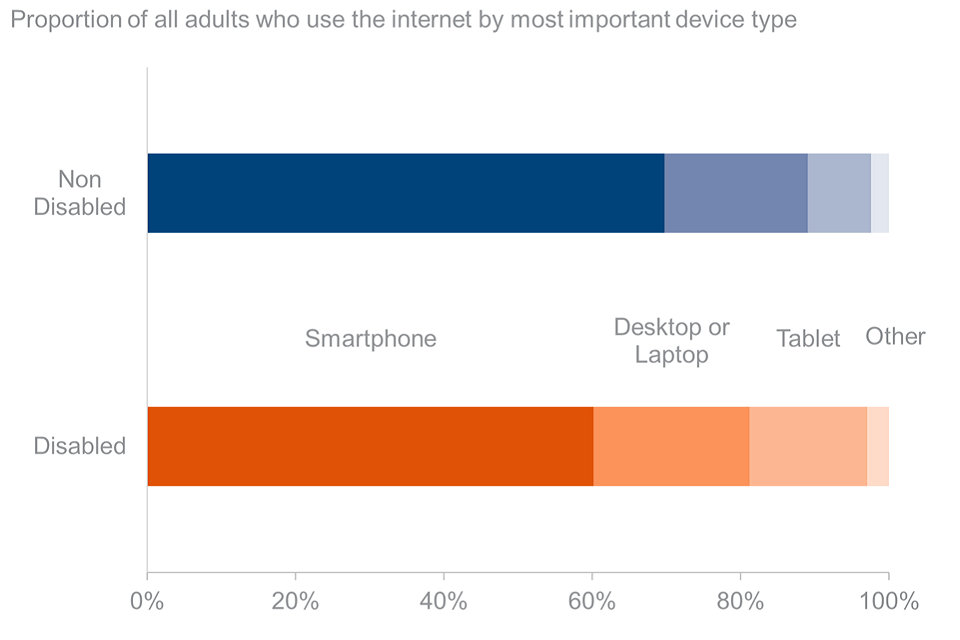
Source: Ofcom Technology Tracker
For over half of disabled people that do have access to the Internet, a smartphone is the most important device for connecting to the Internet.
For both disabled and non-disabled people of working age who have access to the internet, a smartphone is the most important device for connecting to the internet. However, the proportion of disabled people who reported a smartphone as their most important device is lower than the rate for non-disabled people.
This indicates that of those people who do have internet access, a higher percentage of disabled people see a tablet as the most important device for connecting to the internet compared to non-disabled people.
15. Important terms and abbreviations
Terms and abbreviations used throughout this publication
Caseload
The number of people receiving a benefit.
Claim
A request for a benefit.
Disabled people
People with a disability or long-term health condition.
DLA
Disability Living Allowance, which is being replaced by PIP and helps with the extra costs associated with long-term ill-health or a disability.
ESA
Employment and Support Allowance, which people can apply for if they have long-term ill-health or disability that affects their ability to work.
IS
Income Support, which is extra money to help people on a low income or none. You can no longer make a new claim for Income Support. If you’re on a low income and need help to cover your living costs, you can apply for Universal Credit instead.
JCP
Jobcentre Plus, which provide services to some people who require financial assistance.
JSA
Jobseeker’s Allowance, which is an unemployment benefit people can claim while they look for work.
LCW
Limited Capability for Work, a group on UC where you are not expected to look for work right away.
LCWRA
Limited Capability for Work and Related Activity, a group on UC you are not expected to look for work or to prepare for work.
PIP
Personal Independence Payment, which can help people with some of the extra costs associated with long-term ill-health or a disability.
PSP
Personal Support Package, which offers tailored support for people in the ESA WRAG or Universal Credit LCW group.
SG
Support Group, a group on ESA for people who are assessed as not able to get back into work.
SRTI
Special Rules for Terminal Illness, if a person is living with a terminal illness and a doctor or a medical professional has said they might have less than 6 months to live, they may get benefits at a higher rate or get extra money and start getting payments quicker than usual.
TI
Terminal Illness, a health condition that a person will most likely die from.
UC
Universal Credit, which is a payment to help with living costs. It is replacing 6 other benefits. These are:
- Child Tax Credit
- Housing Benefit
- Income Support
- income-based Jobseeker’s Allowance (JSA)
- income-related Employment and Support Allowance (ESA)
- Working Tax Credit
UC*
People on Universal Credit (UC) who have had medical evidence checked as they have a restricted ability to work, or are assessed as LCW or LCWRA.
WCA
Work Capability Assessment, a functional assessment of a person’s fitness to work.
WHP
Work and Health Programme, personal support to help people find and keep a job if they are out of work.
WRAG
Work Related Activity Group, a group on ESA for people who are assessed as able to get back into work in the future.
Definition of medical conditions
ICD Group refers to the World Health Organisations’ International Classification of Diseases (ICD) (2010) Condition Groups. These are sometimes referred to as medical conditions in DWP statistics. For reporting purposes, the conditions as recorded on DWP systems have been mapped to reflect as closely as possible the appropriate ICD10 code. Conditions are based on evidence provided and may not represent a person’s most recent medical condition. Where someone has more than one diagnosis or disabling condition, only the predominant one is reported on in these statistics.
The following abbreviations are used in these statistics.
| Abbreviation used in these statistics | ICD10 Description |
|---|---|
| Infectious Diseases | Certain Infectious and Parasitic Diseases (A00 - B99) |
| Neoplasms | Neoplasms (C00 - D48) |
| Blood/Immune System Diseases | Diseases of the Blood and Blood forming organs and certain diseases involving the immune mechanism (D50 - D89) |
| Metabolic Diseases | Endocrine, Nutritional and Metabolic Diseases (E00 - E90) |
| Mental/Behavioural Disorders | Mental and Behavioural Disorders (F00 - F99) |
| Nervous System Diseases | Diseases of the Nervous System (G00 - G99) |
| Visual Impairment | Diseases of the Eye and Adnexa (H00 - H59) |
| Hearing Impairment | Diseases of the Ear and Mastoid Process (H60 - H95) |
| Circulatory Diseases | Diseases of the Circulatory System (I00 - I99) |
| Respiratory Diseases | Diseases of the Respiratory System (J00 - J99) |
| Digestive Diseases | Diseases of the Digestive System (K00 - K93) |
| Skin Diseases | Diseases of the Skin and Subcutaneous System (L00 - L99) |
| Musculoskeletal Diseases | Diseases of the Musculoskeletal system and Connective Tissue (M00 - M99) |
| Genitourinary Diseases | Diseases of the Genitourinary System (N00 - N99) |
| Pregnancy | Pregnancy, Childbirth and the Puerperium (O00 - O99) |
| Perinatal conditions | Certain conditions originating in the perinatal period (P00-P96) |
| Congenital conditions | Congenital Malformations, Deformations and Chromosomal Abnormalities (Q00 - Q99) |
| Not classified elsewhere | Symptoms, Signs and Abnormal Clinical and Laboratory findings, not elsewhere classified (R00 - R99) |
| External causes | Injury, Poisoning and certain other consequences of external causes (S00 - T98) |
| External causes | External causes of morbidity and mortality (V01-Y98) |
| Health Services | Factors influencing health status and contact with health services (Z00 - Z99) |
| Unknown | Unknown or person without diagnosis on the system |
